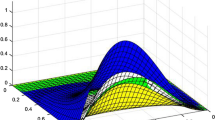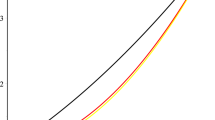Abstract
In this paper, we introduce a family of \(GBS\) operators of bivariate tensor product of λ-Bernstein–Kantorovich type. We estimate the rate of convergence of such operators for B-continuous and B-differentiable functions by using the mixed modulus of smoothness, establish the Voronovskaja type asymptotic formula for the bivariate λ-Bernstein–Kantorovich operators, as well as give some examples and their graphs to show the effect of convergence.
Similar content being viewed by others
1 Introduction
In 1912, Bernstein [1] constructed a sequence of polynomials to prove the Weierstrass approximation theorem as follows:
for any continuous function \(f\in C[0,1]\), where \(x\in [0,1]\), \(n=1,2,\dots \), and Bernstein basis functions \(b_{n,k}(x)\) are defined by
The polynomials in (1), called Bernstein polynomials, possess many remarkable properties.
Recently, Cai et al. [2] proposed a new type λ-Bernstein operators with parameter \(\lambda \in [-1,1]\), they obtained some approximation properties and gave some graphs and numerical examples to show that these operators converge to continuous functions f. These operators, which they called λ-Bernstein operators, are defined as follows:
where
\(1\leq i\leq n-1\), \({b}_{n,k}(x)\) (\(k=0,1,\dots,n\)) are defined in (2) and \(\lambda \in [-1,1]\).
In [3], Cai introduced the λ-Bernstein–Kantorovich operators as
where \(\widetilde{b}_{n,k}(\lambda,x)\) (\(k=0,1,\dots,n\)) are defined in (2) and \(\lambda \in [-1,1]\). He established a global approximation theorem in terms of second order modulus of continuity, obtained a direct approximation theorem by means of the Ditzian–Totik modulus of smoothness and derived an asymptotically estimate on the rate of convergence for certain absolutely continuous functions. Very recently, Acu et al. provided a quantitative Voronovskaja type theorem, a Grüss–Voronovskaja type theorem, and also gave some numerical examples of the operators defined in (5) in [4].
As we know, the generalized Boolean sum operators (abbreviated by \(GBS\) operators) were first studied by Dobrescu and Matei in [5]. The Korovkin theorem for B-continuous functions was established by Badea et al. in [6, 7]. In 2013, Miclăuş [8] studied the approximation by the \(GBS\) operators of Bernstein–Stancu type. In 2016, Agrawal et al. [9] considered the bivariate generalization of Lupaş–Durrmeyer type operators based on Pólya distribution and studied the degree of approximation for the associated \(GBS\) operators. In 2017, Bărbosu et al. [10] introduced the \(GBS\) operators of Durrmeyer type based on q-integers, studied the uniform convergence theorem and the degree of approximation of these operators. Very recently, Kajla and Miclăuş [11] introduced the \(GBS\) operators of generalized Bernstein–Durrmeyer type and estimated the degree of approximation in terms of the mixed modulus of smoothness.
Motivated by the above research, the aims of this paper are to propose the bivariate tensor product of λ-Bernstein–Kantorovich operators and the \(GBS\) operators of bivariate tensor product of λ-Bernstein–Kantorovich type. We use the mixed modulus of smoothness to estimate the rate of convergence of GBS operators of bivariate tensor product of λ-Bernstein–Kantorovich type for B-continuous and B-differentiable functions, and establish a Voronovskaja type asymptotic formula for the bivariate λ-Bernstein–Kantorovich operators. In order to show the effect of convergence, we also give some examples and graphs.
This paper is mainly organized as follows: In Sect. 2, we introduce the bivariate tensor product of λ-Bernstein–Kantorovich operators \(K_{m,n}^{\lambda_{1},\lambda_{2}}(f;x,y)\) and the \(GBS\) operators \(UK_{m,n}^{\lambda_{1},\lambda_{2}}(f;x,y)\). In Sect. 3, some lemmas are given to prove the main results. In Sect. 4, the rate of convergence for B-continuous and B-differentiable functions of \(GBS\) operators \(UK_{m,n}^{\lambda_{1},\lambda_{2}}(f;x,y)\) is proved. In Sect. 5, we investigate the Voronovskaja type asymptotic formula for bivariate operators \(K_{m,n}^{\lambda_{1},\lambda_{2}}(f;x,y)\).
2 Construction of operators
For \(f\in C(I^{2})\), \(I^{2}=[0,1]\times [0,1]\), \(\lambda_{1}, \lambda _{2}\in [-1,1]\), we introduce the bivariate tensor product of λ-Bernstein–Kantorovich operators as
where \(\widetilde{b}_{m,i}(\lambda_{1};x)\) (\(i=0,1,\dots,n\)) and \(\widetilde{b}_{n,j}(\lambda_{2};y)\) (\(j=0,1,\dots,n\)) are defined in (4), \(\lambda_{1}, \lambda_{2}\in [-1,1]\). Obviously, when \(\lambda_{1}=\lambda_{2}=0\), \(B_{m,n}^{0,0}(f;x,y)\) reduce to the bivariate tensor product of classical Bernstein–Kantorovich operators.
The \(GBS\) operators of the bivariate tensor product of λ-Bernstein–Kantorovich type are defined as
for \(f\in C_{b}(I^{2})\). Obviously, the operators \(UK_{m,n}^{\lambda _{1},\lambda_{2}}(f;x,y)\) are positive linear operators.
3 Auxiliary results
In order to obtain the main results, we need the following lemmas.
Lemma 3.1
([4])
For λ-Bernstein–Kantorovich operators \(K_{n,\lambda }(f;x)\) and \(n>1\), we have the following equalities:
Lemma 3.2
([4])
For λ-Bernstein–Kantorovich operators \(K_{n,\lambda }(f;x)\) and \(n>1\), we have
Lemma 3.3
(See [4, Lemma 2.4])
We have
Lemma 3.4
For the bivariate tensor product of λ-Bernstein–Kantorovich operators \(K_{m,n}^{\lambda_{1},\lambda_{2}}(f;x,y)\), we have the following inequalities:
where C is a positive constant.
4 Rate of convergence
We first introduce the definitions of B-continuity and B-differentiability, details can be found in [12] and [13]. Let X and Y be compact real intervals. A function f: \(X\times Y\rightarrow \mathbb{R}\) is called a B-continuous function at \((x_{0}, y_{0})\in X\times Y\) if
where \(\triangle f((x,y),(x_{0},y_{0}))=f(x,y)-f(x_{0},y)-f(x,y_{0})+f(x _{0},y_{0})\) denotes the mixed difference of f. A function \(f: X\times Y\rightarrow \mathbb{R}\) is a B-differentiable function at \((x_{0},y_{0})\in X\times Y\) if the following limit exists and is finite:
The limit is named the B-differential of f at the point \((x_{0},y_{0})\) and denoted by \(D_{B}f(x_{0},y_{0})\).
The function \(f: X\times Y\rightarrow \mathbb{R}\) is B-bounded on \(X\times Y\) if there exists a \(k>0\) such that \(|\triangle f((x,y),(t,s))| \leq K\) for any \((x,y), (t,s)\in X\times Y\).
Let \(B(X\times Y)\), \(C(X\times Y)\) denote the spaces of all bounded functions and of all continuous functions on \(X\times Y\) endowed with the sup-norm \(\|\cdot \|_{\infty }\), respectively. We also define the following function sets:
with the norm \(\|f\|_{B}=\sup_{(x,y),(t,s)\in X\times Y}|\triangle f((x,y),(t,s))|\),
and \(D_{b}(X\times Y)=\{f: X\times Y\rightarrow \mathbb{R}|f \text{ is } B\text{-differentiable on } X\times Y\}\). It is known that \(C(X\times Y)\subset C_{b}(X\times Y)\).
Let \(f\in B_{b}(X\times Y)\). Then the mixed modulus of smoothness \(\omega_{\mathrm{mixed}}(f;\cdot,\cdot)\) is defined by
for any \(\delta_{1},\delta_{2}\geq 0\).
Let \(L: C_{b}(X\times Y)\rightarrow B(X\times Y)\) be a linear positive operator. The operator \(UL: C_{b}(X\times Y)\rightarrow B(X\times Y)\) defined for any function \(f\in C_{b}(X\times Y)\) and any \((x,y)\in X \times Y\) by \(UL ( f(t,s);x,y ) =L ( f(t,y)+f(x,s)-f(t,s);x,y ) \) is called the \(GBS\) operator associated to the operator L.
In the sequel, we will consider functions \(e_{ij}: X\times Y\rightarrow \mathbb{R}\), \(e_{ij}(x,y)=x^{i}y^{j}\) for any \((x,y)\in X\times Y\), and \(i,j\in \mathbb{N}\). In order to estimate the rate of convergence of \(UK_{m,n}^{\lambda_{1},\lambda_{2}}(f;x,y)\), we need the following two theorems.
Theorem 4.1
([7])
Let \(L: C_{b}(X\times Y)\rightarrow B(X\times Y)\) be a linear positive operator and \(UL: C_{b}(X\times Y)\rightarrow B(X\times Y)\) the associated GBS operator. Then for any \(f\in C_{b}(X\times Y)\), any \((x,y)\in (X\times Y)\) and \(\delta_{1},\delta_{2}>0\), we have
Theorem 4.2
([14])
Let \(L: C_{b}(X\times Y)\rightarrow B(X\times Y)\) be a linear positive operator and \(UL: C_{b}(X\times Y)\rightarrow B(X\times Y)\) the associated GBS operator. Then for any \(f\in D_{b}(X\times Y)\) with \(D_{B}f\in B(X\times Y)\), any \((x,y)\in (X\times Y)\) and \(\delta_{1}, \delta_{2}>0\), we have
First, we will use B-continuous functions to estimate the rate of convergence of \(UK_{m,n}^{\lambda_{1},\lambda_{2}}(f;x,y)\) to \(f\in C_{b}(I^{2})\) by using the mixed modulus of smoothness. We have
Theorem 4.3
For \(f\in C_{b}(I^{2})\), \((x,y)\in I^{2}\) and \(m,n>1\), we have the following inequality:
Proof
Applying Theorem 4.1 and using Lemma 3.4, we get
Therefore, (8) can be obtained from the above inequality by choosing \(\delta_{1}=\frac{1}{\sqrt{m+1}}\) and \(\delta_{2}=\frac{1}{ \sqrt{n+1}}\). □
Next, we will give the rate of convergence to the B-differentiable functions for \(UK_{m,n}^{\lambda_{1},\lambda_{2}}(f;x,y)\).
Theorem 4.4
Let \(f\in D_{b}(I^{2})\), \(D_{B}f\in B(I^{2})\), \((x,y)\in I^{2}\) and \(m,n>1\), we have the following inequality:
where C and M are positive constants.
Proof
Using Theorem 4.2 and Lemma 3.4, we have
Hence, taking \(\delta_{1}=\frac{1}{\sqrt{m+1}}\), \(\delta_{2}=\frac{1}{ \sqrt{n+1}}\) and using the above inequality, we get the desired result (9). □
Example 4.5
Let \(f(x,y) = xy+x^{2}\), \(x,y\in [0,1]\), the graphs of \(f(x,y)\) and \(UK_{10,10}^{1,1}(f(s,t);x,y)\) are shown in Fig. 1. Figure 2 shows the partially enlarged graphs of \(f(x,y)\) and \(UK_{10,10}^{1,1}(f(s,t);x,y)\).
5 Voronovskaja type asymptotic formulas for \(K_{m,n}^{\lambda _{1},\lambda _{2}}(f;x,y)\)
In this section, we will give a Voronovskaja type asymptotic formula for \(K_{m,n}^{\lambda_{1},\lambda_{2}}(f;x,y)\).
Theorem 5.1
Consider an \(f\in C(I^{2})\). Then for any \(x,y\in (0,1)\) and \(\lambda_{1},\lambda_{2}\in [-1,1]\), we have
Proof
For \((x,y), (t,s)\in I^{2}\), by Taylor’s expansion, we have
where \(\rho (t,s;x,y)\in C(I^{2})\) and \(\lim_{(t,s)\rightarrow (x,y)} \rho (t,s;x,y)=0\).
Applying \(K_{n,n}^{\lambda_{1},\lambda_{2}}(f;x)\) to (10), we obtain
Taking the limit on both sides of the above equality, we have
Using Lemma 3.2, we have
By Cauchy–Schwarz inequality, we have
Since \(\lim_{(t,s)\rightarrow (x,y)}\rho (t,s;x,y)=0\), using Lemma 3.3, we obtain
Therefore, by (11), (12), (13) and Lemma 3.3, we have
Thus we have obtained the desired result. □
Example 5.2
Consider the function \(f(x,y) = xy+x^{2}\), \(x,y\in [0,1]\). The graphs of \(f(x,y)\) and \(K_{20,20}^{1,1}(f;x,y)\) are shown in Fig. 3. We also give the graphs of \(K_{10,10}^{1,1}(f;x,y)\) and \(UK_{10,10}^{1,1}(f(s,t);x,y)\) in Fig. 4 to compare the bivariate λ-Bernstein–Kantorovich operators with GBS operators.
6 Conclusion
In this paper, we deduce the rate of convergence of GBS operators of bivariate tensor product of λ-Bernstein–Kantorovich type for B-continuous and B-differentiable functions by using the mixed modulus of smoothness, as well as obtain the Voronovskaja type asymptotic formula for bivariate λ-Bernstein–Kantorovich operators.
References
Bernstein, S.N.: Démonstration du théorème de Weierstrass fondée sur la calcul des probabilités. Comm. Soc. Math. Charkow Sér. 13, 1–2 (1912)
Cai, Q.B., Lian, B.Y., Zhou, G.: Approximation properties of λ-Bernstein operators. J. Inequal. Appl. 2018, 61 (2018) http://doi.org/10.1186/s13660-018-1653-7
Cai, Q.B.: The Bézier variant of Kantorovich type λ-Bernstein operators. J. Inequal. Appl. 2018, 90 (2018) http://doi.org/10.1186/s13660-018-1688-9
Acu, A.M., Manav, N., Sofonea, D.F.: Approximation properties of λ-Kantorovich operators. J. Inequal. Appl. 2018, 202 (2018) http://doi.org/10.1186/s13660-018-1795-7
Dobrescu, E., Matei, I.: The approximation by Bernstein type polynomials of bidimensional continuous functions. An. Univ. Timişoara Ser. Şti. Mat.-Fiz. 4, 85–90 (1966)
Badea, C., Badea, I., Gonska, H.H.: A test function theorem and approximation by pseudopolynomials. Bull. Aust. Math. Soc. 34, 53–64 (1986)
Badea, C., Cottin, C.: Korovkin-type theorems for generalized Boolean sum operators. Colloq. Math. Soc. János Bolyai 58, 51–68 (1990)
Miclăuş, D.: On the GBS Bernstein–Stancu’s type operators. Creative Math. Inform. 22, 73–80 (2013)
Agrawal, P.N., Ispir, N., Kajla, A.: GBS operators of Lupaş–Durrmeyer type based on Pólya distribution. Results Math. 69, 397–418 (2016)
Bărbosu, D., Acu, A.M., Muraru, C.V.: On certain GBS-Durrmeyer operators based on q-integers. Turk. J. Math. 41(2), 368–380 (2017)
Kajla, A., Miclăuş, D.: Blending type approximation by GBS operators of generalized Bernstein–Durrmeyer type. Results Math. 73(1), 1–21 (2018)
Bögel, K.: Mehrdimensionale differentiation von funktionen mehrerer veränderlicher. J. Reine Angew. Math. 170, 197–217 (1934)
Bögel, K.: Über die mehrdimensionale differentiation. J. Reine Angew. Math. 173, 5–29 (1935)
Pop, O.T.: Approximation of B-differentiable functions by GBS operators. An. Univ. Oradea, Fasc. Mat. 14, 15–31 (2007)
Gonska, H.H.: Quantitative approximation in \(C(X)\), Habilitationsschrift, Universität Duisburg (1985)
Acknowledgements
We thank Fujian Provincial Key Laboratory of Data Intensive Computing and Key Laboratory of Intelligent Computing and Information Processing of Fujian Province University.
Availability of data and materials
All data generated or analyzed during this study are included in this published article.
Funding
This work is supported by the National Natural Science Foundation of China (Grant No. 11601266), the Natural Science Foundation of Fujian Province of China (Grant No. 2016J05017) and the Program for New Century Excellent Talents in Fujian Province University.
Author information
Authors and Affiliations
Contributions
The authors wrote the whole manuscript. All authors read and approved the final manuscript.
Corresponding author
Ethics declarations
Competing interests
The authors declare that they have no competing interests.
Additional information
Publisher’s Note
Springer Nature remains neutral with regard to jurisdictional claims in published maps and institutional affiliations.
Rights and permissions
Open Access This article is distributed under the terms of the Creative Commons Attribution 4.0 International License (http://creativecommons.org/licenses/by/4.0/), which permits unrestricted use, distribution, and reproduction in any medium, provided you give appropriate credit to the original author(s) and the source, provide a link to the Creative Commons license, and indicate if changes were made.
About this article
Cite this article
Cai, QB., Zhou, G. Blending type approximation by \(GBS\) operators of bivariate tensor product of λ-Bernstein–Kantorovich type. J Inequal Appl 2018, 268 (2018). https://doi.org/10.1186/s13660-018-1862-0
Received:
Accepted:
Published:
DOI: https://doi.org/10.1186/s13660-018-1862-0








